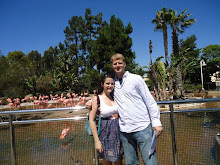
American Born Chinese is a tale of trying to fit in. Initally, we are presented with three different stories, a 'folktale' about the magical monkey king of flower-fruit mountain, the story of Wei-Chen Sun and Jing Wang trying to fit in in an American middle school, and Danny's visits from his cousin Chin-kee. At first these stories appear to have nothing to do with each other, besides a link to being Asian. However, when the stories braid together, Jing Wang/Danny learns a dramatically important lesson about being who you are and remembering where you came from. This theme is universal, and not one that should just be learned by Asian Americans.
Graphically speaking, American Born Chinese has some beautiful moments. My favorite moments are the moments when there are not though bubbles on the page, when the story goes silent. These moments don't need to belong to a specific culture. Isn't any middle school boy on his first date extremely awkward?
Each main character in each individual tale experiences dynamic changes as the plot develops, Jing Wang, Danny and the Monkey King. All learn the theme or moral lesson of the tale, be true to yourself and true affections and friendships will develop.
This book belongs in the hands of students who have trouble fitting in, probably all of them, not just those who are Chinese. This is a great book to book talk, particularly if you have a document camera. Most middle school students would do almost anything to fit in. Thus, as far as the development of the characters goes, it isn't surprising that Jing Want would completely lose his identity and become Danny.
Yang manages to tell a beautifully written and illustrated story with a complicated braided plot line and make a comment on the nature of the Chinese-American immigrant culture. Why is it socially acceptable for every Chinese immigrant to change their names when they move to America?
One thing worth commenting on when assessing the value of a graphic novel are the drawings. In this case they are very vibrant and colorful. An Amazon.com review of the paperback edition of American Born Chinese says that "The artwork, rendered in a chromatically cool palette, is crisp and clear, with clean white space around center panels that sharply focuses the reader's attention in on Yang's achingly familiar characters."
Publisher's Weekley says that "Even when Yang slips in an occasional Chinese ideogram or myth, the sentiments he's depicting need no translation. " To be perfectly honest, these ideograms and myths about Chinese culutre occasionally made me uncomfortable. I think that I could have done without the episode when Chin-kee used the bathroom in one of Danny's friend's Coke. Also, within the first few pages of American Born Chinese , I was a little put-off because one of the characters compliments another character's peaches, which look dramatically like breasts in the drawing. I feel like some of this is inevetable with graphic novels, but also dramataically unessarry.
Inevetiablly, this story is well-written with characters that young people, regradless of race, can identify with. The setting adds a dramatic touch as well with the inclusion of a "folktale" set in ancient China. I feel like there are lessons to be learned here, both on the literal level and on a slightly more personal level.
Using this book in the school setting could be difficult. However, if studying folktales, it would be easy to show and read one section of the book using a document camera to a class of students. Kids might enjoy participating in a reader's theater. However, as the adult in the room it would be important to discuss sterotypes and racism. If students are interested in investigating other cultures, I would reccomend that they read Persepolis by Marjane Satrapi. That story is set in Iran and would require a slightly more advanced reading level than American Born Chinese's 5th Grade level. Another great book would be An Absolutley True Diary of a Part Time Indian by Sherman Alexi.
American Born Chinese was on the list for School Library Journal Best Books of the Year and Publisher's Weekly Best Books of the Year. It also won the Printz Award.
Reference:
Yang, Gene Luen. American Born Chinese. Roaring Book Press, New York: 2006. ISBN 978-1-4299-6936-9








